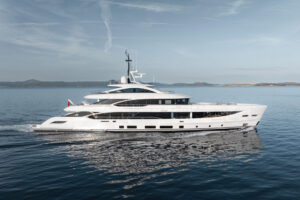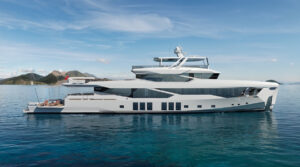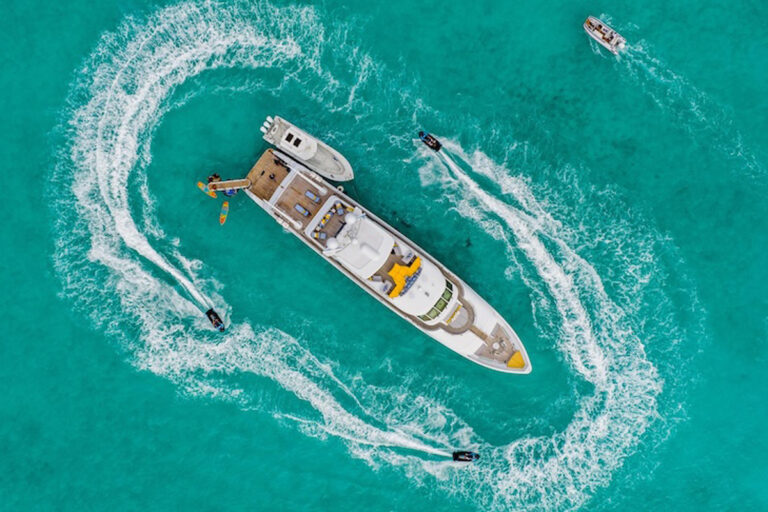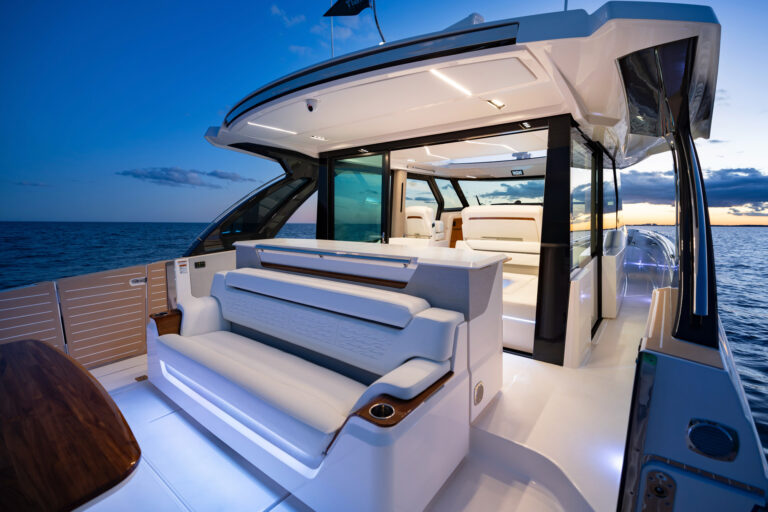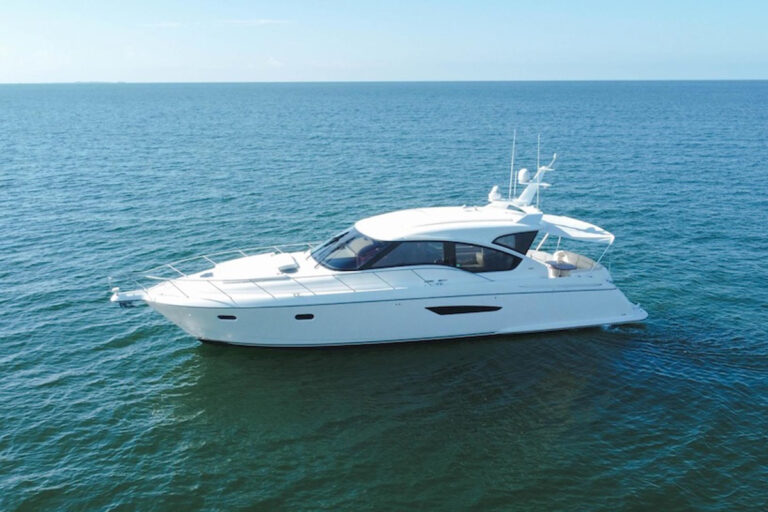If I were cruising far-flung regions of the world where charts are unreliable and repair yards scarce, I’d want a steel bottom underneath me. The steel-hulled Real Ships 57 Pilothouse Trawler is economical with fuel, easy to handle and should allow an extended family to explore distant and tranquil harbors in comfort. With its virtually bulletproof hull, owners will suffer little worry about damage from groundings or collisions with unidentified floating objects.
Steel hulls are rare on production cruisers. With recent advancements in steel yacht- and shipbuilding techniques, the trampy rust bucket is largely a thing of the past.
The 57’s Du Pont Detaclad bonding system actually has been used on ships, including Naval constructions, for more than 30 years. On the 57, it welds the steel hull to the aluminum superstructure. Leaving aside the chemistry lesson, the system is based on a bonded bimetallic strip, which is aluminum on one side and steel on the other. This means the hull and superstructure are bonded to like metals, resulting in a strong weld.
Each Real Ships hull is blasted to near-white and coated with Devoe zinc chromate primer. Awlgrip primer, faring compound and paint complete the finish.
“The paints of today have revolutionized the steel-boatbuilding business. We could not be doing what we do today without these advances, said Joe Johnson, president of the dealership Ships International.
Few materials are perfect. Though the hull is protected from corrosion, owners must be attentive to rust spots that may pop up in tiny nooks, just as they would wax a fiberglass skin and keep sealed any cored construction.
During my time aboard the 57, we headed northeast from Port Everglades Inlet off Ft. Lauderdale, directly into 3- to 5-foot seas. Our destination was the Gulf Stream’s cobalt-blue water, where we were to rendezvous with a Bell helicopter and photographer. There was not much out of the ordinary to report on this sturdy 50-ton ship. Her motion was predictable and steady in every direction, and the ship’s wheel needed little coaxing. With her weighty steel hull and light aluminum superstructure, the 57’s center of gravity was right where it should be: low.
The wipers got a workout as we headed into the sea with a stiff wind blowing off her port quarter. Johnson said the extra spray was due to her bulbous bow. This happened only in that particular sea state.
There was a steady breeze and considerable current by the time I returned to the dock. The 57 responded gracefully to Johnson’s patient engine and thruster commands. An owner/operator with minimal crew will not struggle with handling this rig.
As mentioned, her hull has a bulbous bow, constructed as a separate compartment forward of the stem. This is designed to dampen the ship’s pitch. This trawler has a hard chine and will rest on her own bottom on fixed-bilge keels positioned forward of and abaft the Wesmar hydraulic stabilizer fins. A double bottom exists wherever a tank is positioned. The fuel, water and waste tanks are steel and bonded to the hull.
A flying bridge is aft and accessed through the rear of the pilothouse. When I first reported the Real Ships 57 (On the Docks, May), I was greatly impressed by its placement, and I still am. A wide mast on this deck supports antennae and houses a standard household Trane air conditioner. The rest of the bridge deck is open and can accommodate a 1,500-pound capacity lift and a tender up to 14 feet. Side decks are wide and covered the length of the saloon, which is exposed forward.
Fuel management is perhaps the most crucial element of passagemaking. The published range of the 57 is 4,000 miles at 8.5 knots. User-friendly fuel fills are raised from the side decks. Snorkel vents sit beside each fill. One bulkhead in the engine compartment is dedicated to a bank of manifolds whose red handles direct fuel from various supplies (a 1,100-gallon bow tank and two 800-gallon stern tanks); the Caterpillar continuous-duty 290 hp 3306T feeds off a 130-gallon day tank.
The machinery space is an open compartment with great accessibility and lighting. A Vickers power takeoff runs off the main engine and pushes the hydraulics for the thruster and stabilizers. A sea chest handles raw-water needs. Making repairs while you’re underway, even in an active sea, will be relatively easy, thanks to good headroom, smartly placed grab rails and a work area with toolbox, vise and grinder. The same Speedair compressor that powers the MSDs also powers tools.
As a result of sound reduction in the engineroom, decibel levels throughout the vessel were quite low. The sole in the engineroom is marine plywood with a vinyl diamond-plate skin. Soundown insulation also is used. The generator is in a hush box abaft the engine. Access to the lazarette is beyond the generator. Four emergency pumps are positioned throughout the boat, since not all emergencies occur in the engineroom.
The air conditioning unit is in the mast, contributing to the openness of the machinery space. Johnson likes that it draws less power and is easier to repair than a standard marine unit and, with no seawater lines, can run when the boat is hauled for repairs. In addition, the reduction of water circulating aboard this steel ship will likely cut down on corrosion. A heat strip within the air conditioning unit allows it to warm the cabin. A second marine air conditioning unit is available for the pilothouse, if you need the extra push.
Though doing so takes more time and money, Real Ships avoids hard edges in favor of round shapes. The Portuguese bridge and pilothouse are a prime example. It is hard to identify the material as aluminum.
The pilothouse is my favorite space aboard most yachts, and the 57 did not disappoint. Five panels of half-inch windows set in welded frames provide unlimited lines of sight-as well as confidence for when bad weather sets in. Storm doors with dogs complete the seaworthy image and provide access to the port- and starboard-side decks.
A long watch should pass quickly in the 57’s comfortable helm chair. Crewmembers sharing the duty can dine or spread out a board game on the large table near the center of the upholstered U-shape settee. A pilot berth lowers from behind the settee. To starboard is a terrific work area of Brazilian hardwood with seven drawers and an immense chart flat. Electronics are bracket-mounted. The area in front of the helm is flat. Wire runs are neat and accessed through a panel under the helm.
When you’re off watch, or the destination is at hand, where better to be than the galley? Granite countertops offer the feel of a country kitchen, and four stools create a casual dining venue. Appliances, including a full-size GE refrigerator/freezer, are finished in stainless steel. A Splendide combination washer/dryer is also part of the appliance package. Joinery is American cherry, with professional-grade fit and finish. Owners will have options when it comes to the selection of joinery materials.
Each area of the boat seems spacious, but when I reached the main saloon, I felt a little shortchanged. The L-shape settee was modest, and the size of the saloon seemed small. With the galley, the area is a cozy 15 by 12 feet and has a handsome, rugged appeal. The galley stools and counter supply suitable seating and entertaining platforms. The entertainment center is visible at all points in the saloon and galley. Air handlers off the Trane compressor keep things cool. Headroom is 6 feet, 9 inches. Soft patches in the sole lift for major engine repairs, and overhead panels are removable as well.
The 57 has a three-stateroom, three-head arrangement. Liberal use of wood in the cabins and marble in the heads lends her the quality of a vacation home. Companionways are wide and comfortable, and the guest head functions as a day head. The master and VIP staterooms have queen berths. The guest cabin settee converts to upper-and-lower berths. Fit and finish are unblemished, and hardware is top-notch.
When it comes to trawlers, choices for buyers are always increasing. The Real Ships 57 Pilothouse Trawler has proven herself a worthy contender.
Contact: Ships International, (954) 764-3702; West Coast, (206) 652-4001; www.shipsint.com.


